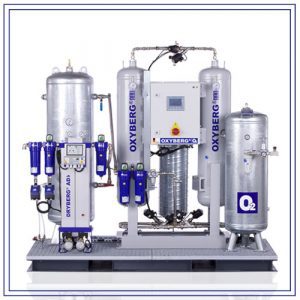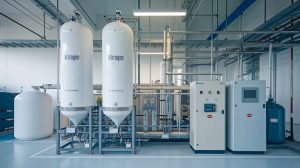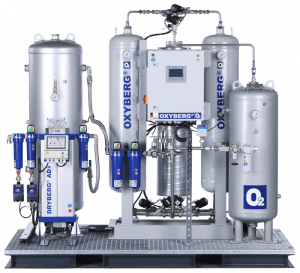Oxygen generators are significant in several industries, supplying high-purity oxygen continuously at the required location within the industries. These generators serve sectors that need oxygen for various processes: manufacturing, healthcare, wastewater treatment, etc. This blog also discusses the operational principle, uses, and advantages of industrial oxygen generators and other oxygen generation systems, such as chemical and synergistic technologies, such as nitrogen generators.
What is an Industrial Oxygen Generator?
This industrial oxygen generator is ultramodern equipment created to produce pure oxygen as required. These generators expunge oxygen from the environment’s air using efficient and sustainable means, replacing cylinder-based oxygen delivery systems.
How Does It Work?
Currently, PSA represents the most used technology in industrial oxygen generation. PSA systems separate the ambient air using a molecular sieve, wherein oxygen is separated from nitrogen and other gasses. This process guarantees constant oxygen production, making it suitable for companies with high demands.
The usefulness of Industrial Oxygen Generator
1. Manufacturing Other than Electronics, Machinery and Equipment, and Metal Products
Industrial oxygen generators are economically vital to metalworking operations such as cutting, welding, and brazing. Oxygen facilitates combustion and enhances cutting-edge definition and the rate at which welds occur. This application increases efficiency and covers uniformity in sectors such as automobiles, naval architecture, and forging machinery.
2. Healthcare Sector
In the healthcare system, oxygen is always in demand because people require it for their everyday lives. Medical oxygen generator are among the special types of oxygen generators commonly used in hospitals, clinics, and other emergency centers. They suppose constant and sure delivery of the ominous oxygen required and intrinsic to surgeries, Intensive Care Units (ICUs), and respiratory therapies.
.3. Wastewater Treatment
Oxygen speeds up biochemical oxidations in a wastewater treatment that removes organic substances from contaminated water. Industrial oxygen generators provide a continuous oxygen supply for optimal aeration, reducing energy costs and enhancing water treatment efficiency.
4. Food and Beverage Industry
The food processing sector agrees with the use of oxygen in packaging and preservation. Oxygen generators also play a role in safety in processes such as beverage carbonation and dairy product production in terms of the right gaseous content.
5. Aquaculture and Fish Farming
Fish farming solutions require oxygen producers to obtain dissolved oxygen into water. This aid helps to boost fish health, increase production rates, and minimize mortality ratios.
Mentioned above are referred to as Chemical Oxygen Generators.
Chemical oxygen generators are compact systems that generate oxygen through chemical reactions. While industrial oxygen generators are fixed installations, these devices are portable and intended for intermittent use during emergencies in locations such as aircraft, submarines, and relief operations.
Chemical oxygen generator are another practical application where mobility or short periods of oxygen availability may be helpful. These devices are independent of electricity, so they can be used in areas with no or little electricity.
Complementary Technology: Industrial Nitrogen Generators
Whereas oxygen generators are expected to facilitate oxidation and combustion processes, nitrogen generators do the opposite of that. Industrial nitrogen generator produce an inert environment needed in industries whereby oxygen leads to fatal reactions. For example:
- Food Packaging: Nitrogen removes oxygen in food packaging to make food last longer.
- Electronics Manufacturing: Here, Nitrogen is used to minimize the effect of oxidation on some delicate parts of the automobile.
- Metal Processing: Nitrogen is used as a welding shield gas.
Nitrogen generators and oxygen generators go hand in hand with each other as they satisfy specific industries’ needs.
Top Benefits of Industrial Oxygen Generators
1. Cost Efficiency
An on-site oxygen generation system, which is quite efficient in usage, reduces dependence on third-party suppliers and transportation means. This is because more disasters occur at the industrial level, thus making it cheaper for businesses to overcome these challenges as compared to losing many clients with their respective individual problems.
2. Environmental Sustainability
Oxygen generators have a lower carbon footprint than cylinder systems as they do not require delivery trucks and have fewer energy-intensive production cycles.
3. Continuous Supply
Some industries that need constant oxygen supply can now produce oxygen at any time through generators. This reliability ensures that those processes that need to be in progress cannot be disrupted.
4. Scalability and Customization
Industrial oxygen generators can be used for small business needs to large industrial plants with significant oxygen requirements. This makes them a flexible choice since they can work for most industries.
Differences between Medical Oxygen Generators and Industrial Oxygen Generators
As much as industrial and medical generators may generate oxygen, the two industrial gasses differ in use and quality. Medical oxygen generators are specifically manufactured to comply with healthcare standards to produce oxygen of medical grade or higher purity for patient treatment. At the same time, Industrial oxygen generators are more focused on process production for industries like manufacturing, metal cutting tasks, water treatment plants, etc.
Organizations Involved in Industrial Gases
Several reputable organizations contribute to advancements in industrial gas technology and sustainable solutions:
- World Health Organization (WHO): Advances medical oxygen generators in the global healthcare systems..
- Environmental Protection Agency (EPA): This agency concentrates on the significance of manners through oxidation in wastewater treatment and sustainability.
FAQs
1. What more does an industrial oxygen generator need for maintenance?
The system’s maintenance includes filter checks, valves, and the compressor. Regular maintenance keeps the system running at its best and also increases its life span.
2. Can industrial oxygen generators operate in remote locations?
In fact, portable oxygen generators can work perfectly well in isolated or small industrial facilities with the necessary infrastructure.
3. What industries benefit most from nitrogen and oxygen generators?
Primary beneficiaries include manufacturing, food packaging industries, firms dealing in aquaculture, electronics industries, and industries in the health sector. These generators fulfill requirements accurately based on industry types.
4. How do chemical oxygen generators differ from PSA oxygen generators?
Chemical oxygen generators provide a temporary oxygen supply through a chemical reaction, while PSA oxygen generators produce oxygen from the ambient air without the need for any chemical reactions.
5. What is the typical lifespan of an industrial oxygen generator?
If well maintained, an oxygen-generating system for industrial use has a life expectancy of 10-15 years. Therefore, it is a cost-effective method of oxygen supply.
Conclusion
Industrial oxygen generators have become essential equipment for most industries; they are cost-effective, environmentally friendly, and efficient compared to conventional oxygen supply methods. Used in many other fields, including healthcare, manufacturing, and wastewater treatment, they effectively meet essential needs. Together with different technologies, such as nitrogen generators, our company specializes in them, and they are critical in overall sustainable industrial development.



